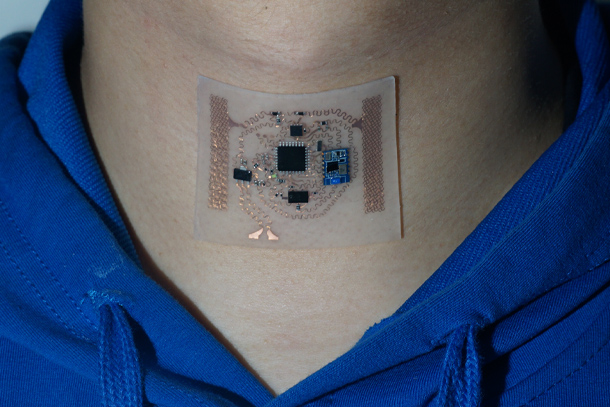
Engineering researchers created a new stretchy, wearable throat sensor that records vibrations and electrical muscle impulses from the neck area to monitor a user’s speech and swallowing patterns. Credit: Provided by Huanyu Cheng
Health data, faster: Wearable stretchy sensor can process, predict health data
December 18, 2023
By Mariah R. Lucas
UNIVERSITY PARK, Pa. — Wearable medical sensors have opened doors for remote health monitoring and treatment evaluation. But making diagnoses and treatment plans based on many datapoints — such as muscle movements, heart rate, breathing, or speaking and swallowing — can be difficult for health care providers to do quickly.
Engineering researchers created a machine learning platform that can more efficiently analyze and predict datapoints collected by wearables, as reported in Nature Communications. They applied the platform to a new stretchy, wearable throat sensor that records vibrations and electrical muscle impulses from the neck area to monitor a user’s speech and swallowing patterns.
“Soft, stretchy on-throat devices are needed in the health care market to continuously monitor the muscle and swallowing movements of patients with throat conditions to properly diagnose and treat them,” said principal investigator Huanyu “Larry” Cheng, the James L. Henderson, Jr. Memorial Associate Professor of Engineering Science and Mechanics at Penn State. “Devices currently in use only provide limited information about the patient’s health condition and are bulky and uncomfortable.”
The wearable patch is composed of a composite hydrogel electrode interface, which was designed to withstand a user’s movements on the skin surface while maintaining good signal quality, according to Cheng. The insoluble hydrogel material is flexible and easy to apply and remove.
“The hydrogel can directly interface with the skin and provides a conductive property for the sensors,” Cheng said.
The hydrogel sensor collects vibrations and muscle movement data to feed a machine learning algorithm for analysis, according to co-principal investigator Libo Gao, associate professor in the Pen-Tung Sah Institute of Micro-Nano Science and Technology at Xiamen University, China. After collection and data analysis, the data is sent to a custom-built cloud interface, where health care providers can access it remotely.
“The patient data is collected by the patch at different frequencies, depending on the statistic type, such as swallowing, speaking or respiration,” Gao said. “The algorithm groups the four frequencies into one streamlined output, which makes the data much more useful for health care providers to quickly look at and judge.”
The algorithm has adaptive capabilities and memory functions, meaning after collecting the patient’s throat movement data for one minute and training offline for three hours, it can predict patient data with over 90% accuracy, according to Gao.
Clinicians can use the predictive data to inform diagnoses earlier, as well as predict how treatments may work, Cheng said.
“Adaptive machine learning could also help account for the individual differences in data among a large population, so that researchers can make inferences on the health of a large population based on individual datasets,” Cheng said.
In addition to Cheng and Gao, the coauthors include Hongcheng Xu, Weihao Zheng, Weidong Wang, Yangbo Yuan, Ji Zhang, Zimin Huo, Ningjuan Zhao, Yuxin Qin, Ke Liu, Ruida Xi, Gang Chen, Haiyan Zhang, Chu Tang and Junyu Yan from Xidian University, China; Yang Zhang, Daqing Zhao and Lu Wang from the Air Force Medical University, China; Yunlong Zhao from Xiamen University, China; Yuejiao Wang from Tsinghua University, China; Qi Ge from the Southern University of Science and Technology, China; and Yang Lu from the University of Hong Kong, Hong Kong SAR.
The National Natural Science Foundation of China, the Natural Science Foundation of Shaanxi Province, the China Postdoctoral Science Foundation, the Fundamental Research Funds for the Central Universities, the Key Research and Development Program of Shaanxi, the Shenzhen-Hong Kong-Macau Technology Research Program, the Fundamental Research Funds for the Central Universities and the Innovation Fund of Xidian University funded this work.



